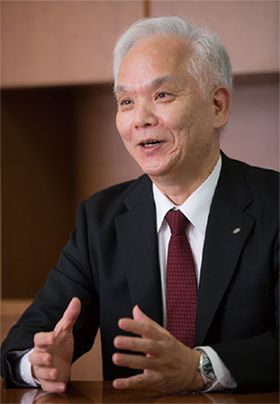About JST
“Promoting a Reform Plan”

HAMAGUCHI Michinari, M.D., Ph.D.
President
Japan Science and Technology Agency
May 2016
JST has finalized the Hamaguchi Plan, in which the organization envisions its future and strives to promote R&D in Japan. I asked JST President HAMAGUCHI about his thoughts on and goals associated with this reform plan, which bears his last name (interviewer: YAMASHITA Reiji, Public Relations Division, JST).
—What was the context in which the Hamaguchi Plan was created?
President: JST’s many achievements have been recognized domestically and abroad since its foundation. We’re ranked third on the Reuters 2016 ranking “Top 25 Global Innovators – Government.” On the other hand, we’re expecting to face a variety of new issues in the future because environments involving our country have been changing rapidly. Without science and technology for the purpose of opening up opportunities in innovation, we won’t be able to avoid these difficult situations. It’s now or never measures must be taken in preparation.
As the only organization in Japan to bring universities, the government and the industrial sector together, JST assumes crucial responsibility in promoting the creation of innovation. In order to adapt to environmental changes and optimize its programs, JST needs to be wise and reinvent itself.
The goal of the Hamaguchi Plan is not only to reform JST. The plan also aims to help research groups in Japan meet the changing needs of society in an environment in which the management strength of the country’s universities has been decreasing every year, as well as optimize the domestic ecosystem as a whole with the goal of achieving innovation.
—The plan includes “establishment of a network-based research institution” and “contribution to regional revitalization.”
JST has advocated a “network-based research institution,” but because it hasn’t been completed as a system, we will be undertaking reforms. As a reference, we would like to use the model of the Defense Advanced Research Projects Agency (DARPA), which has changed the world with the development of the Internet and the Global Positioning System (GPS). DARPA has boldly and proactively carried out promising research projects, despite the risk of failure. JST also needs to intensify ties with universities, research institutes and business enterprises, and dramatically transform itself into an organization that has an independent mind to promote R&D, in addition to the mission of allocating R&D funds to research institutes.
Program managers (PMs) play a crucial role in promoting challenging programs, as they’re responsible for organizing research teams and review programs, consolidating the teams’ structures up to the maximum level and accomplishing goals using their solid leadership skills. JST has planned to set aside funds for a certain percentage of such challenging programs among all of its R&D programs. Developing personnel who support challenging programs like these is also an important mission of ours.
As long as JST claims to be a research institution, we need to have a formal contract with universities so that we have researchers who belong to JST. We’ll ask them to devote time to JST's projects by contract. We want researchers who are busy attending meetings and helping students with their studies to be committed to our research at least during this time.
Next, I’d like to speak about the “contribution to regional revitalization.” The method for allocating operating expense subsidies for national universities has been modified to a degree, and as part of the new method, allocation has been broken down into the three following categories: “regions,” “characteristics” and “world.” JST needs to provide universities that play a central role in these regions with the appropriate support for their characteristics using a variety of our personnel and networks.
Japan’s strength has gradually weakened in rural areas, where the critical problem is a sharp decrease in the population of young people. If the vitality of universities were to give out, the region would no longer be attractive to young people. Industrial strength would also slow down and more young people would leave for cities. JST will strive to identify clues to address this issue through the RISTEX program.
Enhancing our ability to create R&D strategies will go a long way towards helping to analyze issues like these. In order to promote strategies, we want to conduct analyses in a quantitative manner and prepare data with which we can demonstrate the strategies. For instance, we’ll try conducting comparative evaluation and analyses of the achievements of the National Science Foundation (NSF) to determine which projects they have funded and which have been successful.
For these purposes, JST needs to strengthen cooperation with domestic and overseas organizations, including the National Institute of Science and Technology Policy (NISTEP) of the Ministry of Education, Culture, Sports, Science and Technology (MEXT). It is also important to listen to public opinions through the Science Agora and National Museum of Emerging Science and Innovation (Miraikan) and collaborate with society. By cultivating our intelligence regarding science and technology and delivering strategies based on specific evidence, we aspire to bring vigor to R&D in Japan.
— Could you talk to us about future challenges?
There are many things that we can do. Even if it's going to be a long journey, JST will address difficult issues using science and technology and discover methods in which we can move forward – even if it is one step at a time.
